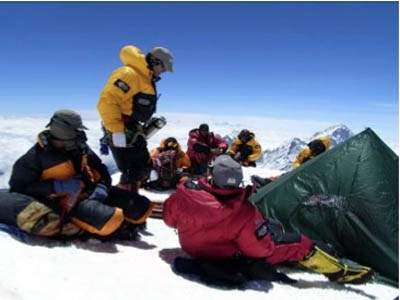
Oxygen sampling on Everest
Newly published results from the medical expedition that went to the summit of Everest revealed that one of the mountaineers had near-fatal oxygen levels in his blood – yet still survived.
The doctor in charge of the expedition said if the man had been a hospital patient, he would have expected death to be near. They were the lowest ever recorded levels of found in humans.
All the summiteers had oxygen levels significantly below normal, with the average being less than half what would be considered to be someone critically ill.
The Caudwell Xtreme Everest expedition put a group of medics on the summit of Everest in May 2007 to study hypoxia – low oxygen blood saturation – and how to treat hospital patients suffering its effects.
The blood samples were taken at a spot dubbed ‘the balcony’, 400m below Everest’s 8,848m (29,029ft) summit – weather conditions prevented them being collected actually at the top – and rushed for analysis to a temporary lab set up at a height of 6,400m.
The blood was taken from leg arteries, which involved temporarily stripping off insulating clothing in temperatures of about –25C.
Expedition leader Dr Mike Grocott, a University College London senior lecturer in critical care medicine, said: “By observing healthy individuals at high altitude where oxygen is scarce, we can learn about physiological changes that can improve critical care at the hospital bedside, because low oxygen levels are an almost universal problem in critical care.
“These extraordinary low levels of oxygen found in high-altitude climbers may cause doctors looking after critically ill patients to revaluate treatment goals in some patients who have been ill for some time and might have adapted to low levels of oxygen in the blood.
“However, our findings will need further careful evaluation before they can be translated into clinical practice. We hope that ongoing research will eventually lead to better treatments for patients with acute respiratory distress syndrome, cystic fibrosis, emphysema, septic shock, ‘blue baby’ syndrome and other critical illnesses.”
The results were published in the New England Journal of Medicine.
As well as the reduced atmospheric oxygen concentrations found on Everest, Dr Grocott said a further possible contributing factor to the low blood levels was accumulation of fluid in the lungs as a result of the altitude.
A party of 200 trekkers also took part in experiments, walking as far as Everest Base Camp and subjecting themselves to constant medical monitoring.
Caudwell Xtreme Everest plans to repeat the trek this year and needs 112 health volunteers to make the journey.
Successful volunteers will spend two days at base camp, and will have the opportunity to meet mountaineers.
Tests conducted on this year’s volunteers are aimed at answering questions posed by analysis of the 2007 data. Volunteers will be expected to attend a day of tests at Archway, north London, before departure.
The first party is due to travel to Nepal in April this year, with further groups following.
The cost of the trip is just under £2,000, with participants expected to raise a further minimum of £700 for the research charity. Places are still available.
Details are on the Caudwell Xtreme Everest website.
See also
High drama: one woman’s Xtreme Everest experience